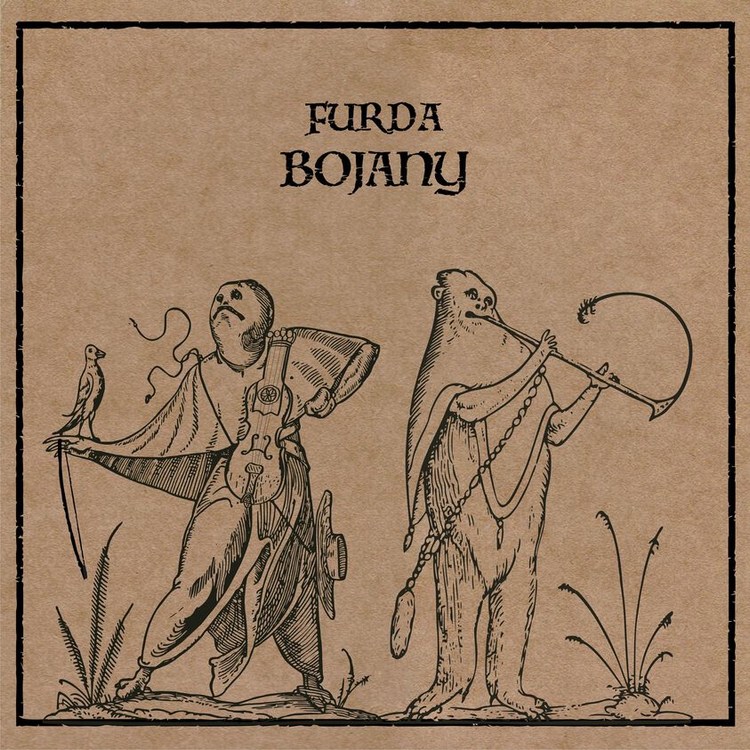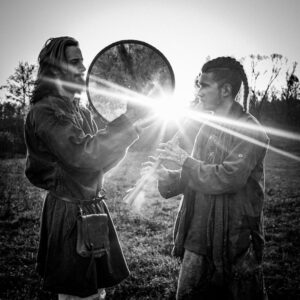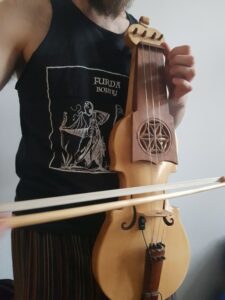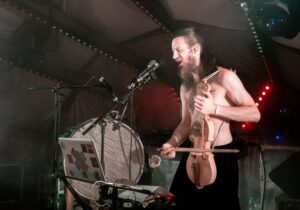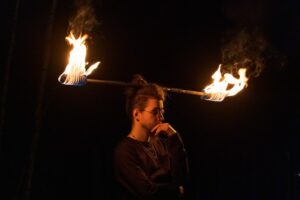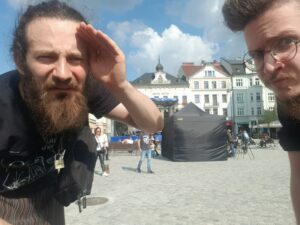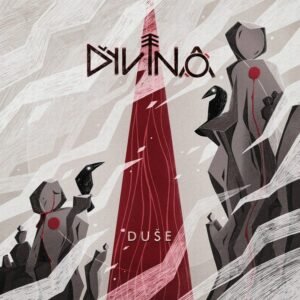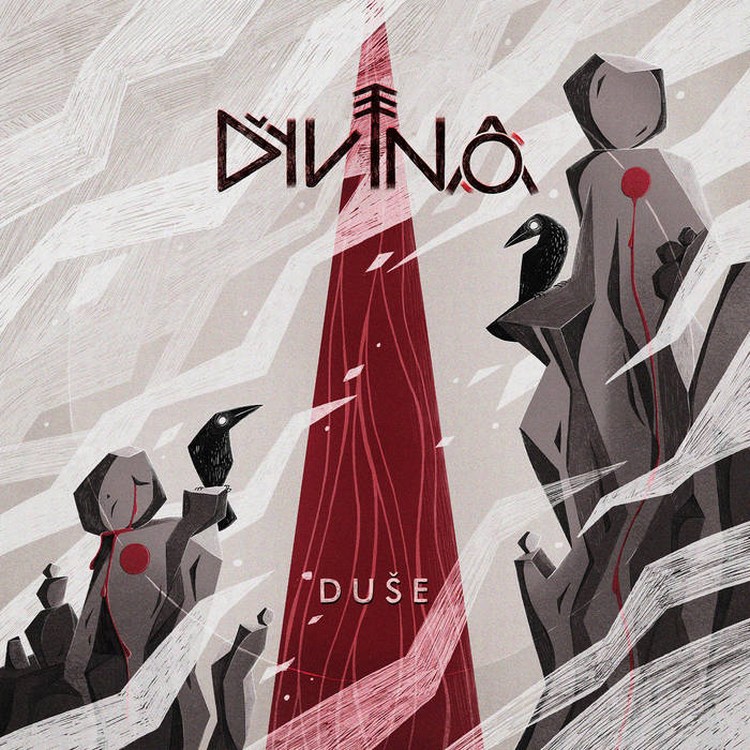I seem to have known Ren (FB) for just as long as I’ve been part of the Alternative Folk scene. I first noticed his talents as he uploaded some snippets of him covering OMNIA songs on Flute. And he continued to do that. Sometimes a cover. Sometimes a doodle he played on a newly built flute, sometimes a sketch he recorded with some new studio equipment he acquired, a bit later also some videos of him working with fire. And every time I was amazed by his talent.
From those first ‘doodles’ on I encouraged Ren to do something with his talent. And boy, did he do just that. In June of last year a package from Poland fell on my doormat. In it was an album called Bojany by the band Furda, a collaboration between Ren and musician/instrument builder Jakub Podskarbi (FB), and it blew me away. Especially the quality and musicianship on it. This was quite some debut they recorded and it didn’t take long before a couple of their songs made it to my personal CeltCast reviewers delights Spotify list. Sadly for them I needed a break from reviewing at that time, so the album never got the attention it truly deserved. Time to make up for it now.
Let’s start by asking Ren (right hand side) how he met Jakub Podskarbi (on the left):
–’ I met Jakub, or cukier (sugar) as we call him, at a Polish folk festival some years ago. We both can’t remember anymore which festival it was.’ He laughs:
–‘ Anyhow, Cukier was playing with his other band at this festival and in the evening we jammed with a group of musicians around a fire probably and that is how we met. After that I worked a while with a member of his other band Sumana (FB), in the end Cukier became involved and that in a way was the start of Furda. Bojany is the first album we recorded together.’
The Album
Well, I’m happy they did as Furda’s music is interesting from the very first beat the recorded. Listening to it with headphones is almost mandatory.
The intro Wdech is an almost improvised percussion piece with added overtone flute. Beautifully mixed by Jakun and Ren, also beautifully mastered by Maurycy Zóltanski (FB).
It’s an intriguing combination of neo-folk with an almost Japanese percussion sauce poured over it. Really cool.
It also has an ‘old ‘ feel to it. As if this song was captured for centuries in the swamps of time and now is suddenly freed again. Like a bubble of methane popping out of the surface.
Title track Bojany
Title track Bojany has that same ‘old’ almost Neolithical feel to it. That feeling is ignited by the haunting sound of the suka biłgorajska: an ancient Polish string instrument, related to the violin but sound wise more similar to the nyckelharpa. It was extinct for a long time, but, like many old instruments in the neo folk scene, was rediscovered and makes its return here.
Ren: –‘Jakub is not only a musician but also an instrument maker who specialises in recreating or restoring old instruments. The instrument you mentioned, the suka biłgorajska is actually made by him. Our goal is to build all the instruments we use ourselves. We also try to achieve an ‘antique’ sound when we record our music, fitting with the instruments we play.‘
Back to the song itself. The deep throat singing, the almost crying duduk, and the before mentioned haunted suka biłgorajska sound make this such a gothic song. With a lovely build up by the way. It keeps growing. An overtone flute solo, a kid running around, (As if Alison Shaw, singer of the Cranes, rushes by). Another old instrument, the jouhikko, makes an appearance as well. You would also think you here some deep synthesizer bass sounds, but Ren tells me that are sounds created by putting the suka biłgorajska through some guitar effects.
–’ We love to do that, take the acoustic instruments and play with them with effects. Because we do it with guitar effects we can reproduce that sound live as well. It’s all part of the improvised live set we play.’
Fooled
Furda made an official video to go with this song and in the accompanying text they explain what the song is about. [or so I thought]
– ‘For quite some time, the scarecrows have been disappearing from the fields. Locals thought this to be a mere prank pulled off by some kids, so one morning they decided to set up a trap for the mysterious jester. No one knows what really happened there, but since that day, all three volunteers, who wanted to catch the scarecrow thief, have not been able to utter a single word apart from B… bo… bo… bo… BOJANY!!!”
Ney Haro
The story, and the overall feel of the album, make me wonder if all the songs on Bojany are based on Polish Folklore. Ney Haro again has that dark feel. This music seems to slowly flow into your living room, caried by thick ‘shards’ of fog. Dark brown from the moors it arose from, black from the branches it past, Greenish wet from the lichen it touched, heavy from the myths it witnessed on its way. Or is it? Looking up the lyrics google translate ended up choosing Bengaly as the source of origin not Polish. I needed to ask Ren about that.
–‘I’m afraid we fooled you on both parts Cliff. Jakub actually made up the story you mentioned. That story that Bojany was based on a Polish Folklore story. [thanks Ren, that takes care of about 5 questions on the subject I had lined up. ] So no, the songs aren’t directly related to any mythical folk tale. Although the village where I live – which is called Bojany – is full of myths and ghost stories, so in a way we were influenced by that. Lisek for instance is based around a Polish nursery rhyme. But most of the stories we created ourselves, just like the story of Bojany.
For your question if there is Bengalese in there. Well no. All the lyrics are either in Polish or -and that goes for almost all of the songs on Bojany– in languages Jakub and me invented. This is something I already do for a long time, even before we started Furda. Almost all the times I wrote a song I would improvise word-like sounds that fitted well with the music , rather than them having a meaning. Its not something I do beforehand. Its more intuitive during the writing process. Only afterwards, transcribing the improvised words I’m singing I discovered that there are similarities in what I sing. That they become sort of an improvised language.’
Fooled again
Well, they got me fooled again it seems. But the song itself is a gem. the build up again is brilliant. It starts with something I can only describe as whispered Neolithical beat boxing. Or to put it differently, as if Gollum mysteriously cloned himself and all the Gollum’s decided to join in just for fun. And this is only the start. One by one elements are added. The suka biłgorajska bass effect sets the dark swamp mood. Gollums beat boxing sets the rhythm. Some humming, some shakers, a frame drum, a xaphoon, one after another shards of music drift into the song. There is no other word for it. And the vocals just finish it of. This is what an Neolithical soundscape should sounds like.
Mythical neo folk fun
An important thing about this whole album: it is fun. That is the really cool part about it all. Although the songs sound dark, like they come from some ancient deep dark Polish primordial wood, they don’t feel black. They have something fun and mischievous about them. Something troll-like.
A song that just screams ‘trollish-mischief’ is Lisek, the song Ren mentioned above. The wailing sound of the suka biłgorajska opening the song is pure genius. You could almost mistake it for the distant chant of a whale. Spooky yet unearthly beautiful. The repeated whispered vocals make this song increasingly eerie. Done like that, the lyrics become the heartbeat the of the song. The rhythm instead of the melody. Trust me, no kid will be soothed by this nursery rhyme. None at all.
Jakub and Ren love to play around with their vocals like this. They use the vocals as yet another instrument to add flavour to their sound. Characters manifest themselves trough their vocals. In this particular case it is as if Jar Jar Binks (Star Wars) joins the trolls for a midnight jam session. The Irish bouzouki riff under the vocal beat is catchy as hell. The soprano recorder and overtone flute solo are the finishing icing on the cake. A cake I gladly skip when the Jar Jar/troll choir picks up speed and ends in a maniacal spiral dance of some sort. This is not music this is a trap. And Furda are luring me in, deeper and deeper. Lisek is easily one of the best songs on Bojany.
Furdana is another of my favourites. Again it starts with a vocal beat indicating the rhythm, which continues throughout the song. The xaphoon -or Sax flute as it is called in Dutch- makes this ballad sound like a beautiful mix of the Nordic folk played by Fuimadane and the Eastern folk melodies we know from Irfan. Ren and Jakub truly created their own musical world. A world slightly dark, a bit gritty, a bit mischievous but with beautiful melodies. And I’m loving it.
Some background
Ren explains about the rhythmical build-up of most of the songs:
–‘ We didn’t get together in the way a band normally would. Actually one day, while we were considering the possibility of maybe doing something together, Jakub just messaged me and said he had arranged a gig for us at a festival. We were due to play 2 weeks later. But we didn’t have a song let alone a set or anything. So we decided twe wanted a two men band, using a lot of our instruments. The only way to do that was using a technique called live looping. A technique were you play a certain melody live and then loop that on the spot, building up a song right there and then as you go. The first gig was a bit hard as we still were learning and we didn’t make it easy on ourselves as we wanted to build up complex songs with many instruments but only played by the two of us and the assistance of those loops. But nowadays it works really well and our live performances are characterized by a lot of improvisation over those loops creating the song base.
Back to that first concert. We met up at Jakubs house in the days before with a lot of instruments and we wrote some song sketches that we rehearsed once before going on stage with them. A rather stressful experience to be honest. After that we worked more on those song sketches and in the end figured out how we could make the whole idea work for us.’
I find it interesting that Ren describe your songs as Sketches, as I have a line in my notes that says: “The music seems to be build up like a painting. First the rhythm – quite often a vocal rhythm – is laid down as a sketch. Then the first melody is thrown down like the base colour of the painting. With that settled, the colours come one by one, brush strokes that add or subtract from the song, slowly but surely building it up to a lovely yet slightly weird piece of musical artwork.”
Exhaustion and carpentry; a very special recording session
The start-up of Furda as a band was a strange one, but the recording of Bojany also wasn’t without its own difficulties Ren explained:
–’ It was in the autumn of ’20/21 that we decided that we wanted to record an album. I live in a wooden house in the forest and we decided to record the album there, taking just two weeks’ time to do it and build a recording studio in my bedroom with Jakub sleeping there with me. Now I can tell you, recording an album in two weeks straight is fun but extremely tiring. . All though the creative part itself is really fun, we won’t do it like that again. As a speedrun like that, waking up, composing, recording, only interrupted by eating and sleeping is extremely exhausting. What made it even harder was that the walls in a wooden cabin are quite thin and my dad’s workshop is right next to my bedroom. And he is a carpenter. So we had to arrange our recording times around his working times to prevent all kinds of weird machine or hammering sounds getting on our sound recordings.’
SeeDish feel
This story reminds me so much of the story of SeeD’s first album. Just going out and recording it in the middle of a forest. In a way Furda and SeeD share this whole ‘forget-about-the-rules-we-just-do-it-like-we-feel’ attitude. They also share that mischievous element in their music. When we come to Zwiędły the similarities become even bigger. This song has something truly SeeDish about it, mixed with an Arabesque flavour for good measure. Ski’la Va is more Trolska Polska meets SeeD featuring Irfan – yes I know, it sounds weird, but trust me, it is there – whereas Skeya Rokha takes me to the early days of OMNIA – especially the Irish Bouzouki part – with Koen (SeeD) on lead vocals.
To be clear these are all just references to give you a sense of the musical diversity that makes up the musical world of Furda. Ren and Jakub let their musical imagination run loose and created a wonderful neo folk world of their own. A world that is unique, intriguing and truly theirs.
Cliff
In this review I used parts of an interview I did with Ren. The whole interview can be found here.
- Editor: Sara Weeda
- Pictures by: Kasia Szyffer (FB) (1)
- Furda (2,4)
- Jerzy Doroszkiewicz (FB) (3)
- Graphic design of the album: Kasia Szyffer
The artwork is from the 1869 reproduction of ‘the drolatic dreams of Pantagruel’ by Louis Perron of Lyon.
Furda can be found here:
- Facebook: @FurdaBand
- Instagram: @furda_band
- Youtube: https://www.youtube.com/FurdaBand
- Spotify: Furda
